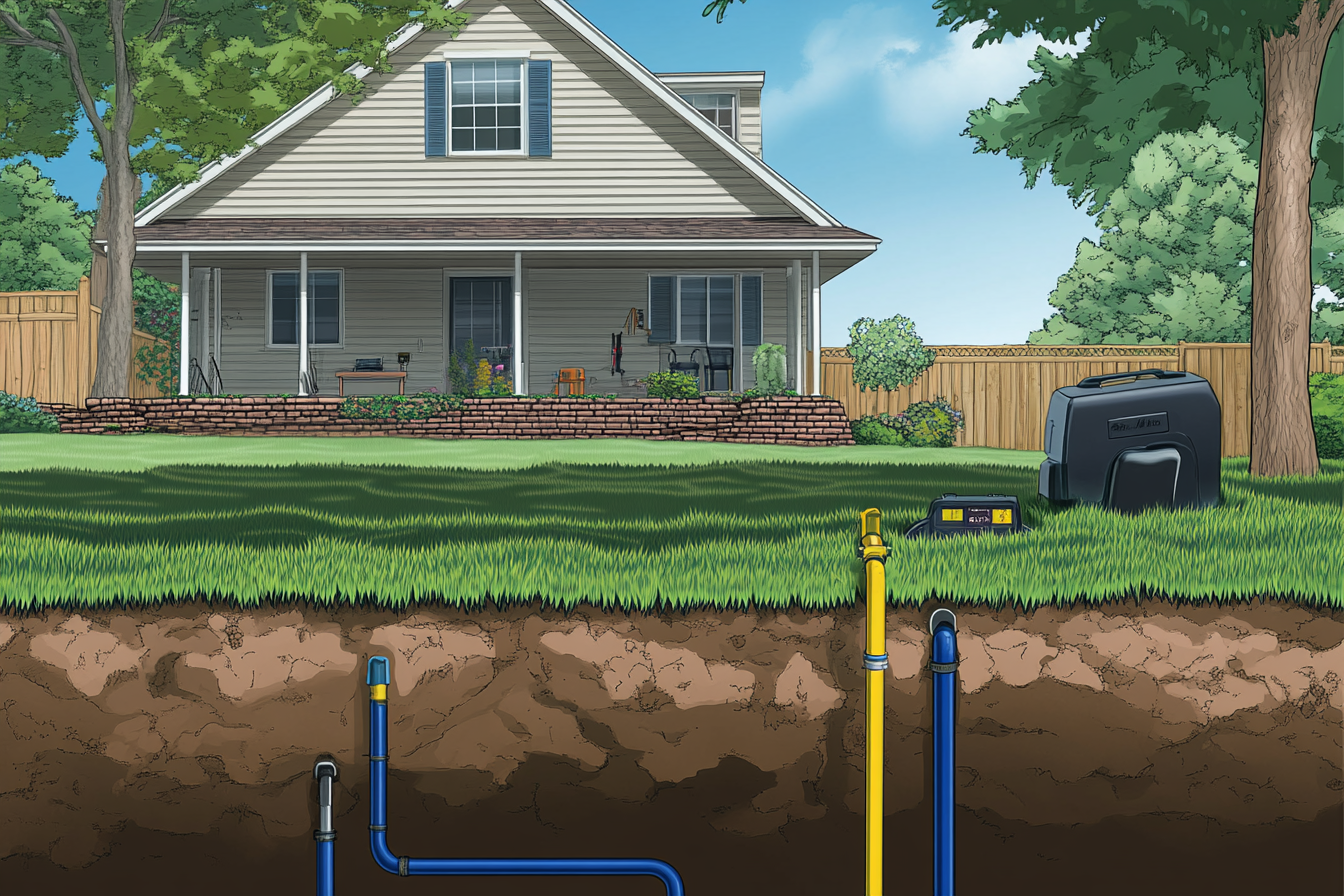Are you wondering how to find underground water lines on your property? Whether you’re planning a landscaping project, need to perform repairs, or want to understand your property’s infrastructure better, locating hidden water pipes is crucial. This comprehensive guide will explore various methods, tools, and best practices for finding underground water lines, helping you choose the most appropriate approach.
- Why It Matters: Prevents damage, ensures repairs, and meets legal requirements.
- Start With: Document research and visual inspection.
- DIY Methods: Metal detectors work for metal pipes, while pipe locators can detect various pipes but may be costly.
- Advanced Methods: GPR offers high accuracy but is expensive, and electromagnetic locators are effective for long distances but less so for non-metallic pipes.
- Process: Research, inspect, use detectors, mark findings, and verify.
- When to Hire Pros: For complex systems, compliance, large projects, or unclear results.
- Safety: Call before digging, follow regulations, and use safety gear.
Finding Underground Water Lines
Why It’s Important
Finding water lines helps avoid damage, saves money on repairs, and follows the law. It’s crucial for planning work on your property.
Finding Methods
You can use simple DIY methods or advanced tools. The choice depends on how complex your situation is.
Step-by-Step
Start by checking documents and looking around. Then use tools like metal detectors. Mark what you find and double-check to be sure.
When to Call Experts
Get professional help for complex systems, big projects, or when the law requires it. They have special tools and knowledge.
Safety First
Always call 811 before digging. Follow local rules, use safety gear, and watch out for other underground utilities.
Helpful Tips
Use multiple methods, keep records, and consider seasonal changes. Learn about your property’s history and use good quality tools.
Always put safety first when finding water lines.
If you’re not sure, ask professionals or your local water company for help.

Why Finding Underground Water Lines is Important
Before we dive into the methods of locating water lines, let’s understand why this task is so crucial:
- Prevent Costly Damage: Accidental damage to water lines during excavation or construction can lead to expensive repairs and potential hazards.
- Efficient Repairs: Knowing the precise location of water lines allows quicker and more targeted repairs when leaks occur.
- Informed Property Planning: Understanding your property’s water infrastructure is valuable for future development and landscaping projects.
- Legal Compliance: Many jurisdictions require utility line identification before excavation work.
Methods to Find Underground Water Lines
1. Non-Invasive Preliminary Steps
Before employing more advanced techniques, start with these non-invasive approaches to finding underground water lines:
1.1 Document Research

- Gather existing property plans, blueprints, or utility maps
- Contact local water utility companies for records of prominent water line locations
- Review any available historical documents related to your property’s infrastructure
1.2 Visual Inspection

Look for visible indicators such as:
- Water meter location
- Outdoor faucets or spigots
- Areas of unusually lush grass growth
- Depressions or settled areas in your yard
These visual cues can help estimate the general path of your water line.
2. Basic DIY Methods
For simple scenarios or initial searches, consider these DIY methods to find underground water lines:
2.1 Metal Detector Technique

| Pros | Cons |
|---|---|
| Effective for metal pipes | Ineffective for non-metallic pipes |
| Relatively inexpensive equipment | Limited depth range |
| Easy to use | Easily confused by other metal objects nearby |
Best for: Locating shallow metal water lines in small areas
2.2 Pipe and Cable Locators

| Pros | Cons |
|---|---|
| Can detect both metallic and non-metallic pipes (with tracer wire) | More expensive than basic metal detectors |
| Provides depth estimation | Requires some training to use it effectively |
| More accurate than basic metal detectors | May not work well near power lines or strong electrical signals |
Best for: Homeowners or contractors dealing with known pipe materials and moderate depths
2.3 Acoustic Leak Detectors
| Pros | Cons |
|---|---|
| Can locate both the pipe and potential leaks | Less effective for non-pressurized or low-flow pipes |
| Works with various pipe materials | It may be affected by external noise |
Best for: Identifying water lines and leak locations
3. Advanced Detection Methods
For more complex scenarios or when higher accuracy is required, consider these advanced techniques to find underground water lines:
3.1 Ground Penetrating Radar (GPR)

| Pros | Cons |
|---|---|
| Highly accurate for various pipe materials | Expensive equipment |
| Can detect pipes at various depths | Requires skilled operation |
| Non-destructive method | It may be affected by soil conditions |
| Provides detailed subsurface images | Data can be complex to understand |
Best for: Large-scale projects, complex underground environments, or when high accuracy is crucial
3.2 Electromagnetic Pipe Locators

| Pros | Cons |
|---|---|
| Can trace metallic pipes or special tracer wires | Less effective for non-metallic pipes without tracer wires |
| Provides depth estimation | It may be affected by nearby metal objects or power lines |
| Effective for long-distance tracing | Can be expensive |
Best for: Tracing long stretches of metallic pipes or pipes with tracer wires
Step-by-Step Guide: How to Find Underground Water Lines

Now that we’ve covered the various methods let’s walk through a step-by-step process to find underground water lines on your property:
1. Start with document research
- Gather all available property documents
- Contact your local water utility for information
2. Perform a visual inspection
- Look for the water meter location
- Identify outdoor faucets and spigots
- Observe ground depressions or unusual grass growth
3. For metal pipes, use a primary metal detector
- Sweep the suspected area slowly
- Mark any solid signals for further investigation
4. Employ a pipe and cable locator
- Follow the manufacturer’s instructions carefully
- Combine with a transmitter for non-metallic pipes
5. Consider using an acoustic leak detector
- Listen for the sound of flowing water
- You can use it to confirm whether a water line is present
6. For complex situations, use GPR
- Hire a professional or rent equipment if you have the expertise
- Scanning the area systematically and analyzing the results
7. Use electromagnetic pipe locators for long distances
- An ideal tool for tracing a water line’s entire length
- It is particularly useful for metallic pipes or those with tracer wires
8. Mark the located water lines
- Use spray paint, flags, or other markers to indicate the path
- Document the findings for future reference
9. Verify findings
- Cross-reference your results with utility company records
- Consider professional confirmation for critical areas
When to Hire Professional Services

While DIY methods can be effective, there are situations where professional utility locating services are recommended:
- Complex Underground Systems: When dealing with multiple utilities or intricate pipe networks
- Legal Compliance: When permits or regulations require professional certification
- Large-Scale Projects: For extensive commercial or industrial sites
- High-Risk Areas: When working near critical infrastructure or hazardous materials
- Inconclusive DIY Results: If your efforts have been unsuccessful or inconclusive
Professional locators typically use a combination of advanced technologies and expertise to provide accurate results, including:
- GPR systems
- Electromagnetic locators
- Specialized software for mapping and documentation
- Knowledge of local utility systems and regulations
Safety Considerations and Legal Requirements

When attempting to find underground water lines, always prioritize safety and legal compliance:
- Call Before You Dig: In many areas, it’s legally required to contact utility companies before any excavation.
- Follow Local Regulations: Be aware of and comply with local utility location and excavation laws.
- Use Proper Safety Equipment: Wear appropriate protective gear when using tools or equipment.
- Be Cautious of Other Utilities: Consider other underground utilities, such as gas or electric lines.
Tips for Successful Underground Water Line Location
To increase your chances of finding underground water lines, remember these tips:
- Combine Multiple Methods: Use a combination of techniques for more accurate results.
- Document Everything: Keep detailed records of your findings, including maps and photographs.
- Consider Seasonal Changes: Be aware that soil conditions can affect some detection methods, so the results may vary by season.
- Understand Your Property’s History: Previous construction or landscaping knowledge can provide valuable clues.
- Invest in Quality Tools: If you frequently need to locate water lines, consider investing in reliable equipment.
- Stay Updated on Technology: The latest advancements in underground utility detection are emerging.
- Practice Makes Perfect: The more you use these techniques, the more proficient you’ll become.
Conclusion: Mastering the Art of Finding Underground Water Lines
Finding underground water lines is invaluable for property owners, contractors, and DIY enthusiasts. Following the steps outlined in this guide and choosing the appropriate method for your specific situation, you can effectively locate your water lines. It will ensure safer property management and more informed decision-making for future projects.
Remember, it’s always best to consult with professionals or your local utility companies when in doubt or when dealing with complex scenarios. Proper knowledge of your underground water lines prevents costly damages and contributes to the overall safety and efficiency of your property’s water system.
Whether planning a simple gardening project or a significant property renovation, finding underground water lines will serve you well. You can confidently and precisely navigate your property’s hidden infrastructure with practice and the right tools.



